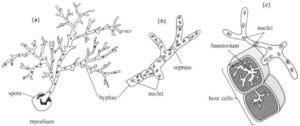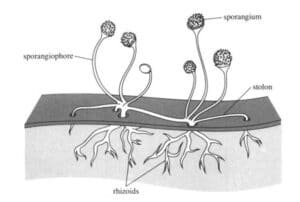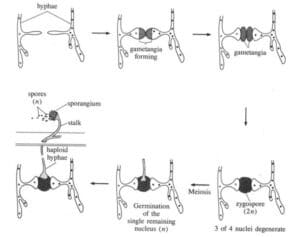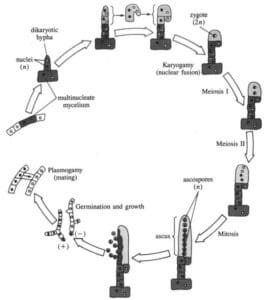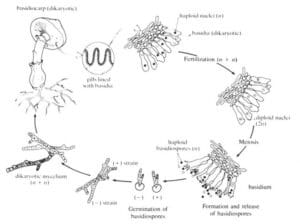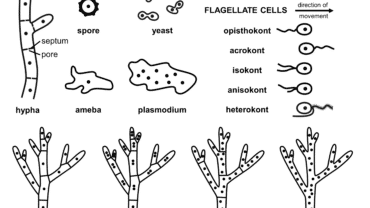Kingdom Fungi
Characteristics of Kingdom Fungi
Fungi are placed in a separate kingdom on the basis of several distinct characteristics.
- They are all eukaryotic, heterotrophic, and, except for yeasts, multicellular (or multinucleate).
- They obtain their food by absorption rather than by ingestion.
- They secrete their digestive enzymes outside their bodies and then absorb the products of digestion produced outside.
- Most fungi possess cell walls made of chitin, an amino-containing polysaccharide.
- They all lack flagella and are restricted in terms of motility.
Examples of Fungi
Yeasts are unicellular fungi believed to have developed from multicellular ancestors. Molds and mushrooms are other examples of fungi. The fungi are at least 400 million years old.
Structure of Fungi
Fungi consist of a tangled mass of multibranched threads called hyphae (see Figure 1). These threads, or filaments, are only incompletely subdivided into separate cells by walls (septa), which are scattered throughout the hyphal network at right angles to the long axis of the hyphae. In most fungi the septa are porous and permit cytoplasmic flow from one “cell” to another. In other groups the nuclei are scattered through a continuous mass of cytoplasm—a coenocytic structure. The entire filamentous mass is called a mycelium. Within the rapidly growing mycelium of parasitic fungi, specialized hyphae called haustoria often appear. In fungi that parasitize plants, these short processes penetrate the plant cells and rapidly absorb whatever nutrients are present there.
The major features of fungal structure. (a) mycelium. (b) septate hyphae with multinucleate cells. (c) coencytic hyphae with haustorium projecting into host cell.
Read the encyclopedia of biology by clicking here
Kingdom Fungi Classification
The more than 100,000 recognized species of fungi fall into four basic divisions. These divisions are roughly comparable to the phyla, which are the major groups within the animal kingdom.
Zygomycota
The Zygomycota (conjugation fungi) occupy a terrestrial habitat, invading the soil or decaying organic matter.
Zygomycota Characteristics
- They usually produce asexual spores at the tips of specialized hyphae (sporangiophores) that extend into the air.
- These spores are carried by the wind to new territory.
- The division is named for the tough resistant zygospores that are formed when haploid gametes fuse, usually under adverse conditions.
- Then, under more comfortable circumstances, the diploid zygospore, which is essentially a zygote with a tough coat, undergoes meiosis.
- One or more of the meiotic products give rise to a new haploid mycelium.
Zygomycota Examples
Rhizopus is a mold that grows on bread. Three varieties of hyphae exist in Rhizopus (Figure 2).
Stolon in fungi
Generally The stolon is a relatively thick filament that grows along the substratum (surface on which the mold grows) in a fairly straight pattern.
Rhizoids in kingdom fungi
Rhizoids are thin, highly branched hairs that penetrate into the interior of the bread and anchor the mycelium. The rhizoids, as a result of both their thinness and great surface area, are particularly effective in absorbing soluble materials formed along the surface.
Sporangiophore
The third type of hypha is the sporangiophore, bearing a sporangium at its end. Each sporangium produces many thousands of spores, asexual cells that give rise to new mycelia. So many spores are produced within each sporangium that an entire slice of bread may be covered with new mycelial growth in a matter of hours.
Reproduction in Zygomycota
In the Zygomycota specialized hyphae from two mycelia of different mating types (+ and —) grow toward each other, forming a conjugation bridge (Figure 3).
Fertilization
Each tip separates as a gamete-producing cell (gametangium) but remains attached to its parent hypha. The gametes fuse to form a zygote (the zygospore) in the middle of the conjugation bridge. The zygospore is surrounded by a thick, spine-covered coat. It usually separates from each of the parent mycelia and may lie dormant for a full season.
Offspring
When reawakened, the zygote undergoes meiosis and one of the haploid cells forms a short hypha, which quickly gives rise to a sporangium at its tip. The spores formed within the sporangium give rise to new mycelia.
Ascomycota
Characteristics of Ascomycota
The very complex and often colorful cup fungi that decorate the ground of many rain forests are also part of this group. Separate cells with perforated septa are common. The name of the group comes from the presence of a reproductive sac called an ascus, which is formed during the sexual cycle of all its members.
Ascomycota Examples
The Ascomycota (sac fungi) include yeasts, some mildews, the ergot (which infects rye), and Penicillium.
Reproduction in Ascomycota
In Ascomycota, asexual reproduction occurs through the creation of spores called conidia, which essentially bud off from conidiophore hyphae of the parent plant and form new mycelia on germination.
Life Cycle of Ascomycota
In sexual reproduction (Figure 4), a plus (female) and a minus (male) strain each form a bulbous, multinucleate body. This called an ascogonium in the plus strain and an antheridium in the minus strain. A cross bridge then forms from the ascogonium to the antheridium. The bridge allows migration of male nuclei into the female organ, which then develops hyphae that are dikaryotic (containing two different nuclei). These hyphae intertwine with haploid hyphae of both parents to form a cuplike ascocarp.
Sac
The dikaryotic components of the ascocarp form terminal, dikaryotic sacs. Within these sacs, the two nuclei unite and undergo meiosis and one mitosis to form eight haploid nuclei. Each sac at this point is called an ascus. Each of the haploid nuclei is incorporated into an ascospore, which, when the ascus ultimately ruptures, is released to begin either an asexual or another sexual cycle.
Sexual reproduction in Ascomycota.
Reproduction in Yeast
Yeasts, although unicellular, are grouped with the Ascomycota. Rather than formation of conidia, their asexual reproduction involves budding.
Budding in Yeast
Firstly In which a new, smaller cell pinches off from the single parent cell. A single yeast cell may also fuse with another of opposite mating strain to form a diploid cell. The fused nuclei then undergo meiosis usually followed by a mitotic division in which eight ascospores are produced. This structure in yeasts is equivalent to the ascus with its eight ascospores formed during the sexual phase of other Ascomycota.
Basidiomycota of kingdom fungi
The Basidiomycota (club fungi) include the very conspicuous mushrooms and toadstools and a variety of puffballs. Here, too, the hyphae are compartmentalized by septa.
Characteristics of Basidiomycota
Firstly In most representatives an extensive underground hyphal mass sporadically sends up vertical hyphal fruiting bodies in which the spores are formed. The reproductive structures found in the fruiting bodies are club-shaped, which gives the group its name.
Basidiomycota reproduction
in mushrooms and other Basidiomycota there is no separate asexual phase in the reproductive cycle (Figure 5). The dense underground mycelial layer gives rise to the compact and dense reproductive fruiting body, therefore we identify as the mushroom, toadstool, or puffball.
Basidia
Club-shaped basidia line the gills, or membranous partitions of the fruiting body, and within the basidium a fusion of haploid cells produces a zygote. Shortly after fertilization, meiosis occurs, and each meiotic product becomes a basidiospore, which leaves through a special extension of the basidium to form new mycelia.
Basidiomycota Life Cycle
Deuteromycota in kingdom fungi
A separate catchall group known as the Deuteromycota comprises all the forms in which a sexual cycle has not been discovered.
Reproduction in Deuteromycota
The Deuteromycota do not demonstrate a sexual phase in their reproductive cycle. They are classified in a single group, but probably they are quite heterogeneous.
Lichens
The lichens are also often separated from other fungi. These intimate mutualistic associations of an algal or cyanobacterial autotroph with a fungus are of great ecological significance. Generally, in temperate or frigid zones the fungal component is an ascomycote. In warm climates the fungus may be a basidiomycote.
Reproduction in Lichens
Firstly In lichens, a fungal spore containing an algal cell embedded in a tangle of hyphae breaks away from the main mass of the lichen. It germinates to form a new spreading mass of intimately connected algal and fungal cells. Sexual reproduction is unknown in the lichens.
How Do Fungi Reproduce?
Most fungi are haploid through much of their life cycle.
Asexual Reproduction in Fungi
When conditions for growth are adequate, reproduction is asexual. Haploid spores form in the sporangia of the sporangiophores. Since these hyphae are haploid, no meiotic process is necessary to produce the many spores that form within the sporangia. When the sporangia burst, the spores are borne by air currents, water, or animals to near or distant sites where suitable substrata may provide opportunities for new mycelial growth.
Sexual Reproduction in Fungi
Sexual reproduction usually occurs when food supplies are low or optimal conditions of moisture and temperature do not exist.
Benefits of Fungi (Economic Importance of Fungi)
Fungi as Decomposer
Along with bacteria, fungi are the most effective decomposers within ecosystems. They not only attack dead material but also break down feces and processed material that could clog vast tracts of the terrestrial environment if not broken down.
Mutualism
Many fungi maintain tight mutualistic relationships with plants. They invade the roots and send hyphae into the soil, substantially increasing the absorption of both water and minerals by the plant. The fungus profits from the carbohydrate and other nutrients provided by the plants. These associations of fungi and root cortex are named mycorrhizae. Their extensive distribution significantly increases the density of plant growth in most terrestrial ecosystems.
Production of Penicillin
A variety of fungi produce antibiotics that can be extracted and used to fight bacterial infections. Penicillium chrysogenum is one of several species of fungus that synthesize and secrete the antibiotic penicillin.
Alexander Fleming
Alexander Fleming, in 1928, first noted that when a Penicillium mold accidentally invaded a petri dish in which bacteria were growing, the bacteria immediately adjacent to the mold colonies were killed. Later penicillin was identified and extracted from the mold in commercial quantities. Streptomycin is another antibiotic which was extracted from a different mold by Wachsman and Schatz at Rutgers University.
Fermentation
Yeasts are the major fermenting organisms in the preparation of such alcoholic beverages as beer, ale, and some wines. Molds are particularly useful in the fermentations accompanying the processing of such cheeses as Camembert and Roquefort.
Harmful Effects of Fungi
Cause Disease
Ergot mold is also the source of ergonovine (Ergotrate) and several derivatives, which are used to control bleeding, foster uterine contractions and combat the pain of migraine headaches. It has also been used to produce hallucinogens.
St. Anthony
St. Anthony’s fire is a disease caused by ingesting rye flour containing poisons produced by an ergot (Claviceps), an ascomycete that infects the rye plant. The toxins produce sensations of burning, frenzied physical activity, and wild hallucinations. During the Middle Ages great epidemics of this poisoning occurred, and sometimes thousands of people were afflicted at one time. In the 1960s a limited outbreak occurred in France.
Hallucinogenic in kingdom fungi
Hallucinogenic substances (also called psychotomimetic agents) like LSD25 are derived from ergot and produce symptoms similar to those of St. Anthony’s fire. A bizarre feature of the hallucinations associated with ergot and its related derivatives is their tendency to produce Technicolor dreams.
Skin Infection caused by kingdom fungi
Harmful aspects of fungal growth include such skin diseases as ringworm and athlete’s foot. Yeast infections of the vaginal tract do not threaten life but are annoying and often difficult to cure. Such “yeasts” are not members of Ascomycota, but, rather, yeastlike imposters from Deuteromycota. Occasionally a fungal infection of the lungs may kill susceptible individuals.
Fungi as Parasite
Fungal parasites of plants cause large-scale destruction of growing crops. The rusts, which attack wheat, and the smuts, which overwhelm the floral parts of many plants, are Basidiomycota and can cause considerable damage. In addition, a large variety of molds tend to rot vegetables and fruits that are stored after harvest.




